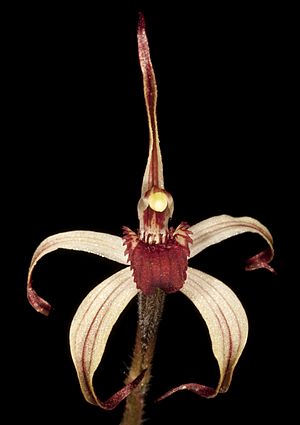Caladenia drummondii facts for kids
Quick facts for kids Winter spider orchid |
|
|---|---|
 |
|
| Scientific classification | |
| Genus: |
Caladenia
|
| Species: |
drummondii
|
| Synonyms | |
|
Arachnorchis drummondii (Benth.) D.L.Jones & M.A.Clem. |
|
The Winter spider orchid (Caladenia drummondii) is a special type of orchid that only grows in the south-west part of Western Australia. It's called a "spider orchid" because its flowers can look a bit like a spider! This plant has a small, hairy leaf and usually one beautiful flower. The flower is often cream-colored with deep purplish-red parts. Its side petals and sepals (which are like outer leaves of a flower) often hang downwards.
Contents
What Does the Winter Spider Orchid Look Like?
The Winter spider orchid starts with a single leaf. This leaf is about 10–40 mm (0.4–2 in) long and 8–10 mm (0.3–0.4 in) wide. After the flower blooms, the leaf grows larger, becoming about 50–70 mm (2–3 in) long and 12–15 mm (0.5–0.6 in) wide. The leaf feels hairy and is green on top, with a purplish color underneath.
The Flower's Features
The flower stem grows to be 60–100 mm (2–4 in) tall. Usually, there is only one flower on each stem. The flower itself is about 20–30 mm (0.8–1 in) long and 20 mm (0.8 in) wide. It is white with darker lines. The sepals and petals (parts that look like flower leaves) have brownish tips that are 8–16 mm (0.3–0.6 in) long.
Sepals and Petals
The top sepal, called the dorsal sepal, stands straight up. It is 15–30 mm (0.6–1 in) long and about 1–1.5 mm (0.04–0.06 in) wide at its base. The two side sepals, called lateral sepals, are also 15–30 mm (0.6–1 in) long and 2–3 mm (0.08–0.1 in) wide. They spread out near the bottom but their tips hang downwards. The petals are 12–30 mm (0.5–1 in) long and 3–3.5 mm (0.12–0.14 in) wide. They also turn downwards and have twisted ends.
The Labellum
The labellum is a special lip-like part of the orchid flower. For the Winter spider orchid, it is dark purplish-red. It has small, blunt teeth along its edges and its tip curves downwards. There are also four or more rows of dark red bumps, called calli, along the center of the labellum. You can see these beautiful flowers from late April to June.
How the Winter Spider Orchid Got Its Name
The Winter spider orchid, Caladenia drummondii, was first described in 1873. A botanist named George Bentham wrote about it in his book Flora Australiensis. He named it after James Drummond, who was the person who first collected a sample of this orchid near the Swan River. The name drummondii is a way to honor him.
Where Does the Winter Spider Orchid Live?
This orchid is found in many places between Lake King and Nerren Nerren station, which is near Kalbarri. It grows in different types of plant communities. These include mallee areas (where many small, multi-stemmed eucalyptus trees grow), Melaleuca thickets (dense groups of Melaleuca shrubs), and York gum woodlands. These areas are part of the Avon Wheatbelt, Geraldton Sandplains, Mallee, and Yalgoo biogeographic regions in Western Australia.
Is the Winter Spider Orchid Safe?
The Government of Western Australia's Department of Parks and Wildlife has looked at the Winter spider orchid. They have classified it as "not threatened." This means that it is not currently in danger of disappearing.

